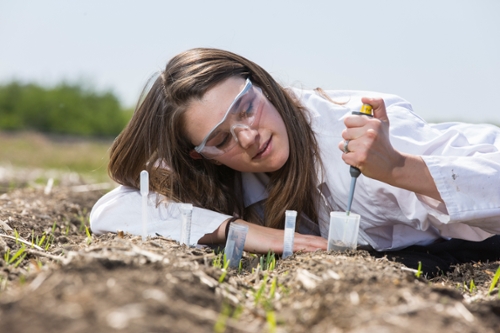
Student research helps West African farmers
A prairie girl, Alexis Adams spent most of her life in Saskatoon, but she left her heart with impoverished farmers in Mozambique during a 2012 summer trip to Africa.
“African farmers are hard-working and innovative,” said Adams. “I want to work with them to break the cycle of poverty for future generations.”
Adams vowed to help by improving local soil fertility, so she enrolled in a soil science master’s program at the University of Saskatchewan.
Now she is studying the impact of micro-dosing, a new fertilizing practice, on soil fertility in the Sahel region of West Africa which suffered a catastrophic famine in 2012.
But spreading fertilizer across the fields is too expensive a solution for smallholder farmers.
With micro-dosing, farmers place an affordable bottle-cap-sized quantity of mineral fertilizer near the planting hole when the seeds sprout. Research has shown that short-term yield almost doubles using half the fertilizer, boosting the farmers’ revenue.
Micro-dosing and rainwater harvesting techniques, promoted by the U of S and other researchers, have so far improved the livelihoods of more than 10,000 farmers in West Africa by increasing crop productivity.
But the long-term impact of micro-dosing on soil fertility has been an open question, and now Adams may have the answer.
The concern has been that harvesting permanently removes nutrients from the soil and that the small doses of added nutrients may not be enough for the plants, which could then start drawing on stored nutrients.
Adams has shown that micro-dosing is a viable alternative to extensive fertilizing.
Using the Canadian Light Source synchrotron at the U of S, she found that micro-dosing does not deplete soil nutrients over time any more than would occur with extensive fertilizing.
“This is good news for smallholder farmers because they can micro-dose fertilizer and still see a return, lowering their costs and risks,” said Adams.
Adams analyzed the chemical indicators of soil fertility by comparing samples she took from across the Sahel to soil left unfertilized or treated with extensive fertilizing.
She found that the yield declined over time no matter which fertilizer treatment was used. That’s because the region’s heavy reliance on tillage and crop residue removal hinders the buildup of nutrients and organic matter in the soil.
To address this problem, Adams recommended adding manure and other organic matter along with micro-dosing.
Adams hopes her research will spur African policy-makers to increase farmers’ access to fertilizer and promote best practices for fertilizer use.
“I want to work for a company or non-governmental organization in Africa, making sure effective technology gets to farmers,” she said.
Her research is funded by national agencies NSERC, the International Development Research Centre and Foreign Affairs, Trade and Development Canada through the Canadian International Food Security Research Fund.
The research team, led by soil science professor Derek Peak, will receive more than $500,000 towards a $4.45-million project in partnership with the University of Manitoba and three universities in Nigeria and Benin to expand novel farming practices to 50,000 farmers.
By Federica Giannelli is a graduate student intern in the U of S research profile and impact unit
Please include this after the story: This article first ran as part of the 2015 Young Innovators series, an initiative of the U of S research profile office in partnership with the Saskatoon StarPhoenix.
Photo credit: David Stobbe for the University of Saskatchewan

